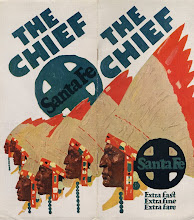GIFTS AND ACQUISITIONS FROM THE CALIFORNIA ANTIQUARIAN BOOK FAIR, TED PIETSCH, AND THE LIBRARY OF JOHN GLADSTONE
Thanks to the generosity of a couple of new friends and long-time Wolfsonian supporters, I have the pleasure of announcing that we have been able to add some important rare titles to our library collection in the first few months of the year. Our collections development policy at the Wolfsonian is to make strategic acquisitions designed to build upon the strengths of our current holdings and to fill in important gaps in the collection as rare materials become available. Naturally, in the current climate of economic recession and shrinking budgets, we have been ever more dependent on donations of rare materials in expanding our library holdings. Fortunately, a number of friends of the library have stepped up to the plate early this year with pledges of support and donations of rare and reference works appropriate to our collecting interests.


The first materials to arrive this year came courtesy of Ruth Kruger, a collector who donated a number of vintage postcards from her own collection to the library in January. She also introduced me to the Tropical Post Card Winter Show in Pompano Beach, Florida, and her generosity inspired me to open up my own wallet to purchase and donate a few World War I, World War II, World's Fair, and Tennessee Valley Authority postcards to the collection as well.


Wolfsonian museum founder, Mitchell Wolfson, Jr. generously pledged to match the library’s acquisitions budget and doubled our purchasing potential at the California Antiquarian Book Fair this last February. Thank to his continued support and contributions from Ellen and Louis Wolfson III we were able to pick out a few rare and important additions to our collection, including: a bound edition of deck plans for the Norddeutscher Lloyd, Bremen steamship company for the year 1912; a pictorial map of Havana, 1939; a rare Thonet catalog for chairs; a late 1930s illustrated book about automobiles; anti-Nazi cartoons and caricatures in a book and periodical from the Netherlands; and a Berliner Secession book on a sports art exhibition in 1927.


Long-time supporter Frederic A. Sharf, (who recently donated a large number of rare viewbooks on the Spanish American war, the Russo-Japanese war, the Sino-Japanese conflicts, etc.), augmented his own donation by facilitating the gift of more than thirty sketchbooks and one hundred original design drawings by automotive artist Theodore W. Pietsch II by his son and namesake. This very significant donation goes a long way towards helping to establish the Wolfsonian’s reputation as a critical repository of automobile design materials.


Finally, I would be remiss if I neglected to acknowledge the continued generosity of Ideal Gladstone. Every year since 2006, Ideal has invited us to sift through her late husband’s library to select whichever rare and reference books we deemed appropriate for our collection. Her husband, John, was a real renaissance man, and his library has proven to be a real gold mine for important reference works on such diverse subjects as: art history; the American labor movement; Communist art and aesthetics; World’s Fairs; and illustrated books by Rockwell Kent and others. The contributions of these and other donors can be accessed through our library donor webpage by clicking on the title of this blog.






















































